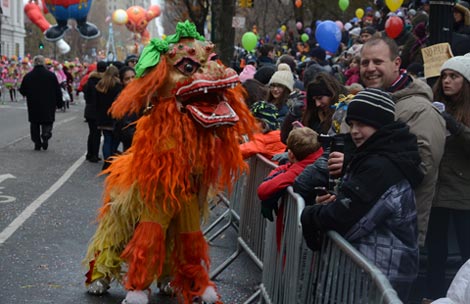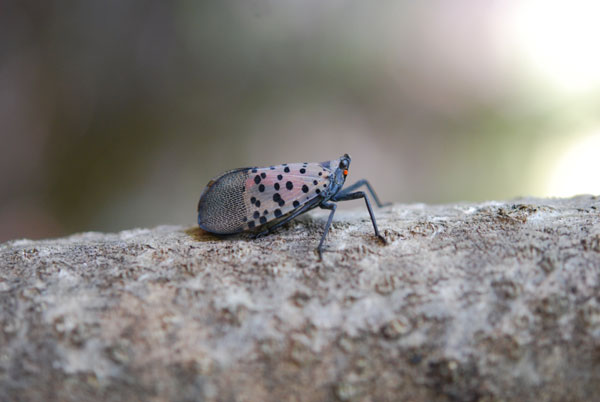Spotted lanternfly invades US
Updated: 2014-11-27 10:03
By JACK FREIFELDER in New York(China Daily USA)
|
||||||||
An invasive insect new to the United States that has the potential to impact the grape, fruit tree and the hardwood industries has been discovered in Pennsylvania. Now the race is on to educate the US population to help contain the menace, according to a pair of experts.
As far as scientists know, the spotted lanternfly is so far located in just one county in Pennsylvania, according to Gregory Parra, staff scientist with the US Department of Agriculture's (USDA) Center for Plant Health Science Technology (CPHST).
"The information gathering process is extremely preliminary right now," Parra told China Daily. "But we have to keep an eye on ways that this insect might be transported or moved unknowingly."
The spotted lanternfly, known formally as Lycorma delicatula, is native to a number of Asian countries, including China, India, Japan and Vietnam. Officials estimate that the lanternfly's presence could pose a threat to more than 50 species of trees in the US.
The bugs attack trees by feeding on sap and can cause further damage by excreting large amounts of fluid on tree surfaces that encourage the growth of mold. Mold can hinder plant growth and weaken trees to make them more susceptible to other pathogens.
Trees attacked by the Spotted Lanternfly will show a gray or black trail of sap down the trunk.
Pennsylvania is leading the effort right now to get people involved and there are plans for further outreach.
"There was also a technical working group formed for this insect, and people are in the process of identifying experts and reaching out to get more collaboration," Parra said.
Gregory Hoover, an ornamental extension entomologist at Penn State University, said lines of communication need to be built up to inform residents of the impact this invasive species could have.
"We have a lot of folks that need to be trained with regard to what to look for," Hoover said. "Our 'search image' for detecting this insect has switched from predominantly adults to the overwintering mass of eggs."
"There are a lot more eyes among residents than there are among specialists, and what often occurs is homeowners are usually the pairs of eyes that see these things first," he said. "So there's a real need to educate all of those individuals."
On Nov 1, Pennsylvania state officials announced a quarantine to contain the presence of the species in the Pike and District townships of Berks County, Pennsylvania (northwest of Philadelphia). The first presence of the bug in the US was confirmed in September.
Pennsylvania Agriculture Secretary George Greig said in a Nov 3 statement: "Berks County is the front line in the war against the spotted lanternfly."
"Since this is new to the country we are taking every precaution and measure possible to learn more, educate the public and eliminate this threat to agriculture," Greig said. "We need to do everything we can to stop the spread. We're asking a lot, but we know Pennsylvanians will assists us and help save our fruit trees, grapes and forests."
The quarantine of the two townships in Berks County "restricts movement of any material or object that can spread the pest," Pennsylvania's Agriculture Department said in a Nov 3 release. The list of objects that could potentially transport the bug includes: wood products, yard waste, packing materials, and any other equipment not stored indoors.
Jae Geun Kim, the author of Cyclic Behavior of Lycorma delicatula on Host Plants, an October 2011 report published in the Journal of Insect Behavior, said the presence of the lanternfly could be tough to corral in any environment because it has "no natural enemy".
"Knowledge on behavior and host plant preferences is critical to develop novel and effective pest management strategies," Kim wrote.
Parra, with the CPHST, said the spotted lanternfly is not much of a strong flier, so the main concern and risk is associated with "human-assisted movement".
CPHST, one of the branches of the USDA's Animal and Plant Health Inspection Service (APHIS), has more than 200 staff members who provide scientific analysis and support for USDA regulatory decisions.
"As long as officials have an idea on the infested area, they can really get the word out and prevent any movement outside of that area," Parra said. "If they do that they might have a very good chance of decreasing the population, and their goal of course would be eradication."
jackfreifelder@chinadailyusa.com

 Across America over the week (Nov 21- Nov 27)
Across America over the week (Nov 21- Nov 27)
 Daredevil dancer conquers mountain
Daredevil dancer conquers mountain
 Chinese float gives joy at Macy's parade
Chinese float gives joy at Macy's parade
 Calm comes to troubled Ferguson
Calm comes to troubled Ferguson
 6 things you should know about Black Friday
6 things you should know about Black Friday
 Visa change may boost tourism to the US
Visa change may boost tourism to the US
 China's celebrity painters
China's celebrity painters
 Beauty of Beijing float making debut in Macy's parade
Beauty of Beijing float making debut in Macy's parade
Most Viewed
Editor's Picks

|

|

|

|

|

|
Today's Top News
China, US fight terror on the Internet
How to give is focus of philanthropy forum
China, US diverge on approaches to nuclear energy
China's local govt debt in spotlight
Macy's looks to appeal to more Chinese customers
Clearer view of Africa called for
Cupertino, California council is majority Asian
BMO Global Asset Management Launches ETFs in Hong Kong
US Weekly

|

|








